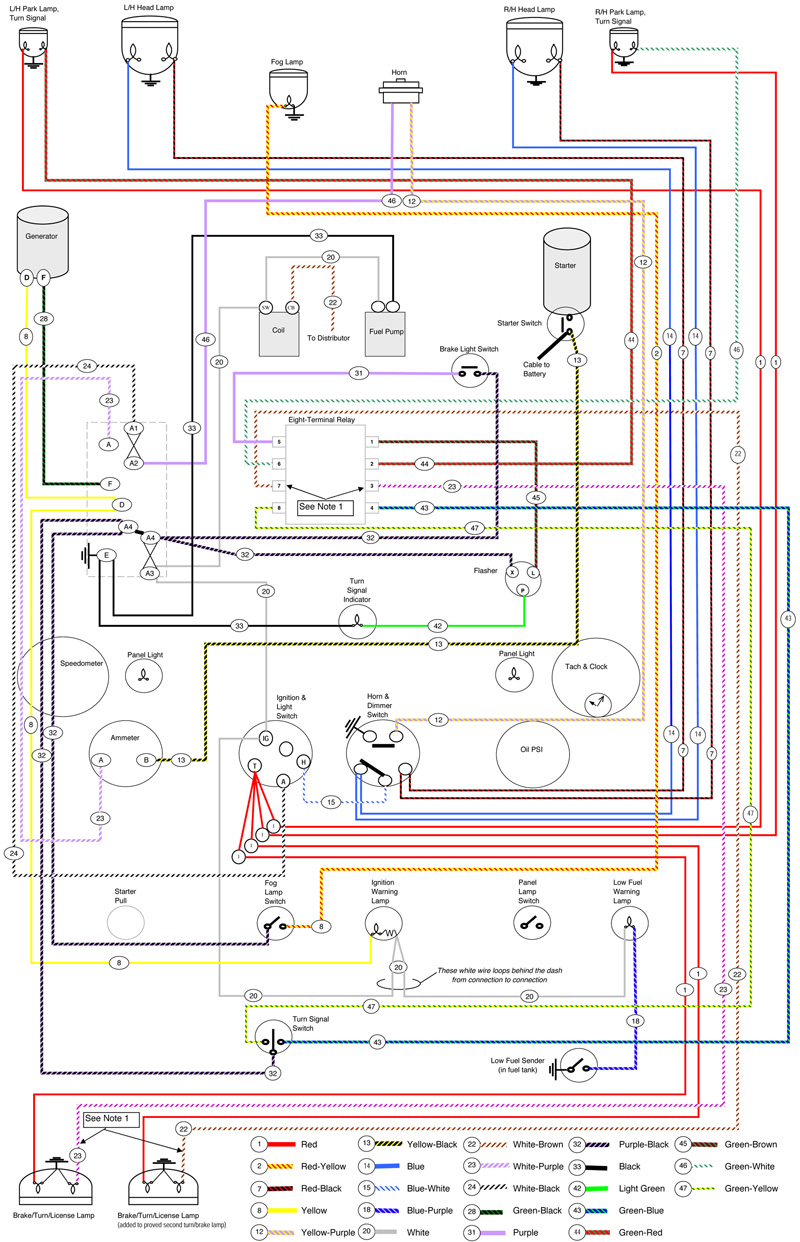When remembering the outstanding scientists and inventors of yore, several great names immeadiately come to mind: Edison, Bell, Tesla.
But then, there is Lucas…the Prince of Darkness. This man is singularly famous for turning electrical science into a black art. When it comes to Lucas electrics, it’s really all about preventing the smoke from escaping the wiring harness.
It may be helpful to compare electricity in your LBC to the water in your household plumbing. The water pressure is like the voltage in your battery, and the wires like pipes. In the case of Lucas electrics, the electricity is in the form of smoke, which must not be allowed to escape the system!
When examining the typical British car wiring diagram, one might be overwhelmed by the complexity. The trick is not to view things as a whole, but concentrate on the individual circuit. Learning the basic color code will make things easier:
Black wires are earth (aka ground) and connect one side of the battery and all electrical components to the car chassis.
Brown wires are direct from the other battery post and always hot.
Purple wires are the same as brown, only with a fuse.
White wires are hot only when the ignition switch is on.
Green wires are the same as white, only with a fuse. Note that on very early cars, there are just the two fuses!
There is more:
Blue wires feed the dimmer switch and are hot (typically not fused!) when the headlight switch is on.
Blue with white stripe, and blue with red stripe are the high and low beams from the dimmer switch to the headlights.
Red wires feed the runnings lights and are hot (typically not fused!) when the switch is on.
Red with white stripe wires are the same as red, only with a fuse and feed the dash lights.
Green with white stripe and green with red stripe are the turn signal wires.
It gets worse:
Pretty soon they ran out of combinations and began reversing the main color/stripe color combinations. For instance, white with a red stripe is the lead from the ignition switch to the starter solenoid, not to be confused with the dash lights.
The important thing to remember is that in most cases the main color of any striped wire indicates its origin. For instance, a purple wire with a stripe going to the horn lets you know that this circuit is fed by a fused wire that is always hot. Similarly, the green with stripe wires in the brake light, wiper, or gauge circuit is fed by the fused ignition switch. See, it is all very simple! On later cars, more colors were added.
Next project: How to bleed excess smoke from the system.
By Mike McPhail
Gulf Coast Austin-Healey Club
Hill Country Triumph Club
You can right-click the following images, open them in a new window and enlarge them.










'Pint Size Project — Lucas Wiring' have 4 comments
March 15, 2013 @ 12:39 pm Jimmy Young
I love you guys.
December 1, 2015 @ 1:10 am Jay
From what source does the ignition switch get power. What wire supplies the juice, thanks Jay
January 3, 2017 @ 7:56 am loys Cauvin
Hi,
i cannot reed note 1 about eight terminal relay on the loom showed up(for mg tc) entire replacement.
Thanks.
Best regards.
November 2, 2017 @ 2:01 pm peter jones
hi, I love the wiring diagrams and how they are colour coded with an explanation of each function below, can you do one for a Morris Mini Cooper s mk11 like that please all my information is rather sketchy on re wiring my car so would really appreciate if you could do the same with a cooper s mk2 late 60’s, my mini is/was a deluxe 68 a bare shell with nothing in it whatsoever, but have a new loom and with all other things turning it into a Cooper s …no pretense just as a project to keep my sanity. thanks muchly